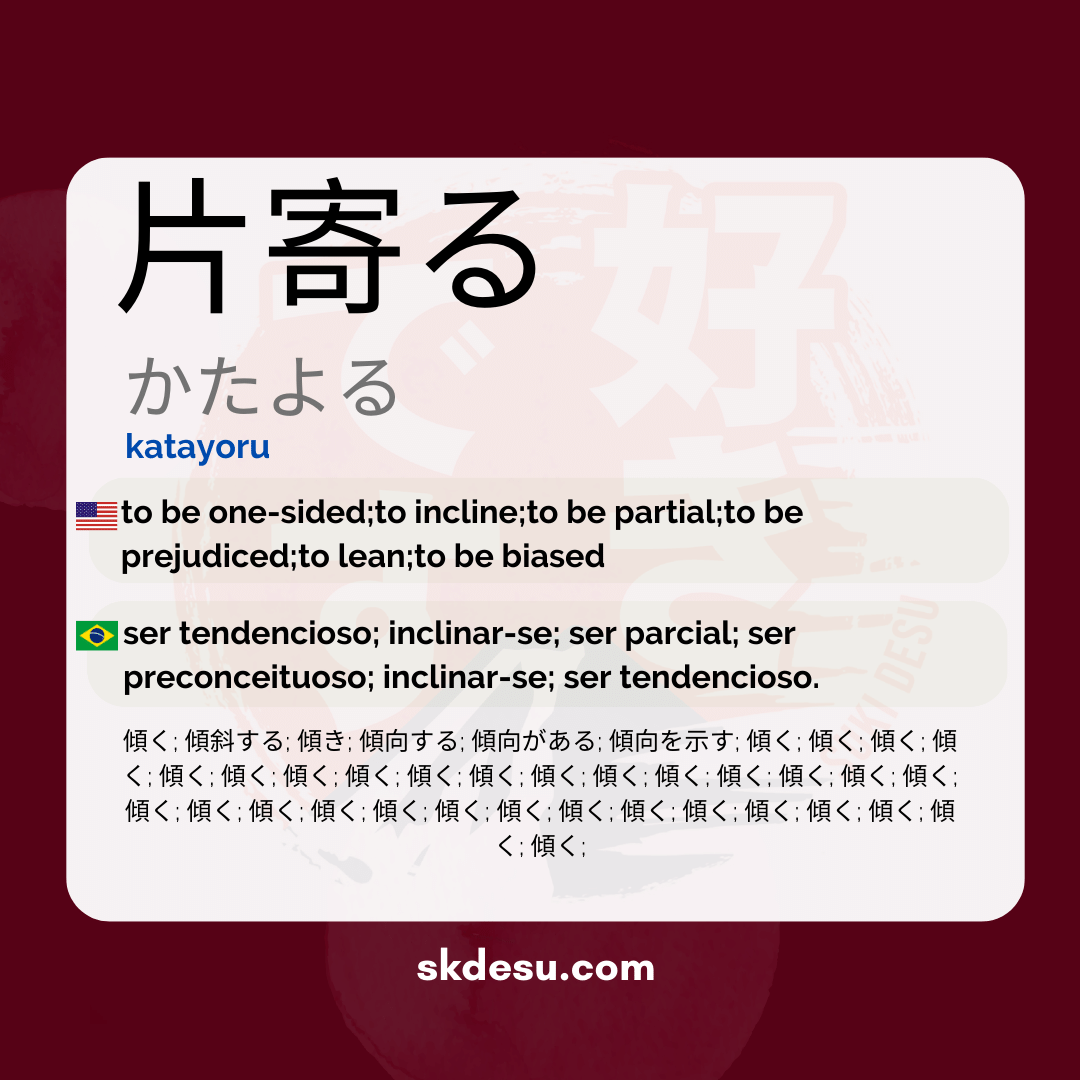Translation and Meaning of: 片寄る - katayoru
A palavra japonesa 片寄る (かたよる) pode parecer simples à primeira vista, mas carrega nuances interessantes que valem a pena explorar. Se você está estudando japonês ou apenas tem curiosidade sobre o idioma, entender seu significado, origem e uso prático pode ser bastante útil. Neste artigo, vamos mergulhar nos detalhes dessa expressão, desde sua composição em kanji até como ela é percebida no cotidiano japonês. Se você busca um dicionário confiável para aprofundar seus conhecimentos, o Suki Nihongo é uma ótima referência.
Meaning and use of 片寄る
片寄る (かたよる) is a verb that means "to lean to one side," "to be biased," or "to be unbalanced." It can be used in both a physical and a figurative sense. For example, if a shelf is crooked, you can say that it is 片寄っている (かたよっている). In a social context, the word can also indicate an excessive preference for something, as in "biased opinions."
It is worth noting that 片寄る is not an extremely common term in everyday life, but it appears in more formal discussions or specific descriptions. Its figurative use, in the sense of "partiality," is more frequent in critical texts or analyses. For Japanese learners, it's useful to know this word to avoid confusion with similar terms like 偏る (かたよる), which has a similar but not identical meaning.
Origin and composition of kanji
The writing of 片寄る is composed of two kanji: 片 (かた), which means "side" or "part", and 寄る (よる), which means "to approach" or "to lean". Together, they form the idea of something that leans to one side. It is interesting to note that the radical 片 appears in other words related to laterality, such as 片側 (かたがわ, "one side") or 片手 (かたて, "one hand").
Do ponto de vista etimológico, 片寄る surgiu como uma forma de descrever desvios físicos, mas seu uso se expandiu para o campo abstrato. Fontes como o Kanjigen e o Jisho.org confirmam que essa evolução semântica é comum em muitos verbos japoneses, especialmente os que envolvem movimento ou direção.
Tips for memorizing and using correctly
An effective way to remember 片寄る is to associate it with concrete situations. Imagine an unbalanced scale or a person who only hears one side of a discussion. This type of visualization helps to retain both the meaning and the context of use. Another tip is to practice with short sentences, such as "この意見は片寄っている" (This opinion is biased), to internalize the grammatical structure.
Interestingly, the verb is less used in the imperative form or in casual conversations. Its tone is more descriptive, so avoid using it in informal situations unnecessarily. For those who use apps like Anki, creating flashcards with real examples from articles or news can be a smart strategy to master its nuances.
Vocabulary
Expand your vocabulary with related words:
Synonyms and similar words
- 傾く (katayuku) - lean; tilt
- 傾斜する (keisha suru) - to incline; to have an inclination
- 傾き (katamuki) - inclination; angle of inclination
- 傾向する (keikou suru) - to tend; to have a tendency
- 傾向がある (keikou ga aru) - to have a tendency to; to tend to something
- 傾向を示す (keikou o shimesu) - indicate a trend
Related words
Romaji: katayoru
Kana: かたよる
Type: Verb
L: jlpt-n2, jlpt-n1
Translation / Meaning: be biased; bow down; be partial; being prejudiced; bow down; be biased.
Meaning in English: to be one-sided;to incline;to be partial;to be prejudiced;to lean;to be biased
Definition: becomes unstable.
Quick Access
- Vocabulary
- Writing
- Sentences
How to Write in Japanese - (片寄る) katayoru
See below a step-by-step guide on how to write the word by hand in Japanese. (片寄る) katayoru:
Example Sentences - (片寄る) katayoru
See below some example sentences:
Nenhum resultado encontrado.
Other Words of this Type: Verb
See other words from our dictionary that are also: Verb
kiru
cut; chop; grind; sculpt; saw; trim; shear; slice; peel; knock down; cut down; pound; separate (connections); pause; interrupt; disconnect; turn off; hang up the phone; cross (a street); give a discount; sell below cost; shake (water) off.

